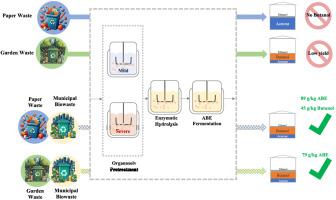当前位置:
X-MOL 学术
›
Biomass Bioenergy
›
论文详情
Our official English website, www.x-mol.net, welcomes your feedback! (Note: you will need to create a separate account there.)
Enhanced biobutanol production with sustainable Co-substrates synergy from paper waste and garden waste with municipal biowaste
Biomass & Bioenergy ( IF 5.8 ) Pub Date : 2024-06-19 , DOI: 10.1016/j.biombioe.2024.107262 Sara Farmanbordar , Armaghan Javid , Hamid Amiri , Joeri F.M. Denayer , Keikhosro Karimi
Biomass & Bioenergy ( IF 5.8 ) Pub Date : 2024-06-19 , DOI: 10.1016/j.biombioe.2024.107262 Sara Farmanbordar , Armaghan Javid , Hamid Amiri , Joeri F.M. Denayer , Keikhosro Karimi

|
Synergy in the co-processing of lignocellulosic wastes and municipal biowaste (MB) can unlock their potential for biobutanol production. This study assessed the potential for biobutanol production through the co-processing of lignocellulosic waste and MB. Specifically, it compared the co-processing of paper waste with MB to that of garden waste and MB. Ethanol organosolv pretreatment served as a dual-function process for both pretreatment and detoxification purposes. Initial fermentation of hydrolysates from untreated paper waste using produced 0.9 g/L of acetone and ethanol but no detectable butanol. Organosolv pretreatment led to a significant increase in acetone and ethanol production but did not yield butanol. Co-processing paper waste with MB using organosolv pretreatment resulted in the production of 2.8–3.2 g/L butanol, along with increased acetone and ethanol production. Furthermore, co-processing a 1:1 (w/w) mixture of paper waste and MB under mild and severe pretreatment conditions produced 45.5 g and 43.4 g butanol, respectively, compared to 34.8 g and 14.4 g butanol when processing these waste streams separately. The study also explored the positive impact of co-processing garden waste with MB, a distinct lignocellulosic source, enhancing acetone-butanol-ethanol (ABE) yield by 27–40%. These findings highlight the potential of synergistic waste co-processing for achieving a more suitable balance of nutrients to enhance biobutanol and ABE production from biowastes. Additionally, the simultaneous treatment of lignocellulosic waste and municipal biowaste offers a simplified approach to waste processing, contributing to advancements in sustainable biomass utilization and bioenergy production.
中文翻译:

利用废纸和园林垃圾与城市生物垃圾的可持续共底物协同作用,提高生物丁醇产量
木质纤维素废物和城市生物废物(MB)协同处理可以释放其生产生物丁醇的潜力。本研究评估了通过木质纤维素废物和 MB 的协同处理生产生物丁醇的潜力。具体来说,它将造纸废物与甲基溴的协同处理与花园废物和甲基溴的协同处理进行了比较。乙醇有机溶剂预处理作为预处理和解毒目的的双重功能过程。使用未经处理的废纸对水解产物进行初步发酵,产生 0.9 g/L 的丙酮和乙醇,但没有检测到丁醇。有机溶剂预处理导致丙酮和乙醇产量显着增加,但没有产生丁醇。使用有机溶剂预处理将废纸与 MB 进行共处理,产生了 2.8–3.2 g/L 的丁醇,同时丙酮和乙醇的产量也有所增加。此外,在轻度和重度预处理条件下共同处理废纸和 MB 的 1:1(w/w)混合物分别产生 45.5 克和 43.4 克丁醇,而单独处理这些废物流时分别产生 34.8 克和 14.4 克丁醇。该研究还探讨了花园废物与 MB(一种独特的木质纤维素来源)协同处理的积极影响,将丙酮-丁醇-乙醇 (ABE) 产量提高 27-40%。这些发现凸显了协同废物协同处理的潜力,可以实现更合适的营养平衡,从而提高生物废物中生物丁醇和 ABE 的产量。此外,同时处理木质纤维素废物和城市生物废物提供了一种简化的废物处理方法,有助于可持续生物质利用和生物能源生产的进步。
更新日期:2024-06-19
中文翻译:

利用废纸和园林垃圾与城市生物垃圾的可持续共底物协同作用,提高生物丁醇产量
木质纤维素废物和城市生物废物(MB)协同处理可以释放其生产生物丁醇的潜力。本研究评估了通过木质纤维素废物和 MB 的协同处理生产生物丁醇的潜力。具体来说,它将造纸废物与甲基溴的协同处理与花园废物和甲基溴的协同处理进行了比较。乙醇有机溶剂预处理作为预处理和解毒目的的双重功能过程。使用未经处理的废纸对水解产物进行初步发酵,产生 0.9 g/L 的丙酮和乙醇,但没有检测到丁醇。有机溶剂预处理导致丙酮和乙醇产量显着增加,但没有产生丁醇。使用有机溶剂预处理将废纸与 MB 进行共处理,产生了 2.8–3.2 g/L 的丁醇,同时丙酮和乙醇的产量也有所增加。此外,在轻度和重度预处理条件下共同处理废纸和 MB 的 1:1(w/w)混合物分别产生 45.5 克和 43.4 克丁醇,而单独处理这些废物流时分别产生 34.8 克和 14.4 克丁醇。该研究还探讨了花园废物与 MB(一种独特的木质纤维素来源)协同处理的积极影响,将丙酮-丁醇-乙醇 (ABE) 产量提高 27-40%。这些发现凸显了协同废物协同处理的潜力,可以实现更合适的营养平衡,从而提高生物废物中生物丁醇和 ABE 的产量。此外,同时处理木质纤维素废物和城市生物废物提供了一种简化的废物处理方法,有助于可持续生物质利用和生物能源生产的进步。






































 京公网安备 11010802027423号
京公网安备 11010802027423号